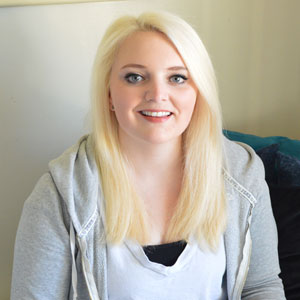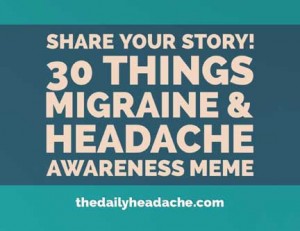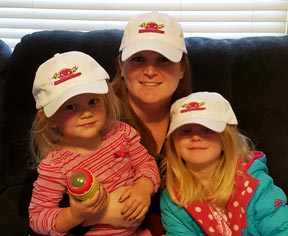Sarah, a 20-year-old student at Brigham Young University—Idaho, shared this essay she wrote about living with chronic migraine for her English class.
Pain in My Brain
By Sarah Smith
 I bury my head into my pillow trying to apply pressure to my skull. I pull up the covers to block out any light and hopefully to muffle any sound. I lay there motionless. My head throbs, pulsating, feeling as if at any moment it may explode. Dizziness sets in, and I continue to not move; maybe it’ll go away. I start to feel nauseous. I lay there with nothing but this pain and my thoughts: “How long will this last? Why can’t things just be normal?”
I bury my head into my pillow trying to apply pressure to my skull. I pull up the covers to block out any light and hopefully to muffle any sound. I lay there motionless. My head throbs, pulsating, feeling as if at any moment it may explode. Dizziness sets in, and I continue to not move; maybe it’ll go away. I start to feel nauseous. I lay there with nothing but this pain and my thoughts: “How long will this last? Why can’t things just be normal?”
I have suffered from chronic migraine since I was five years old. Growing up, doctors would tell me that, “Your migraines will probably go away when you have menopause.” This was not very reassuring to hear. When I reached the age of 14, I started going to a neurologist. I would meet with him every three months and answer all of his questions and give him a review of my health. He prescribed me some medication that only helped some of the time. Eventually, when I was about 15, my neurologist suggested that I get an MRI, which I did, but there was nothing to be found. I continued to take medications for my migraines until I was about 17 when I decided that I didn’t want to be dependent on pills, and that I should try to figure out the triggers that cause my migraines.
Because I get migraines so often, about 3-4 days a week, it was/is hard to pinpoint exactly what the triggers are. It didn’t take long to discover my biggest migraine culprit – florescent lighting. Since the lighting of a room is not something I get to decide, it is extremely difficult to prevent a migraine from happening in these situations. If I’m in a room with florescent lights for a short period time, it’s not that much of a problem. However, high school was incredibly difficult for me, because I was around these lights for eight hours at a time. Much of the time my migraines will last more than a day. Because of this, I would go to school for a day, get a migraine, and miss the following day. This happened so frequently that I missed a large portion of my senior year and almost didn’t graduate.
Some of my other triggers include wind, long exposure to the sun, bright lights, loud noises, inconsistent sleep schedule, and eating more sugar than normal. The symptoms I have from migraines vary on the degree of pain. I usually experience blurry vision, dizziness, nausea, and severe headache.
I have found that the best cure for a migraine is simply to sleep. I will often also take ibuprofen or Excedrin Tension Migraine. Sometimes, even these don’t work, and I just have to wait the migraine out. These are the worst types of migraines, because no matter what I do I just need to let the migraine run its course.
In addition to almost not graduating high school, my migraines have impaired other aspects of my life. When I have a migraine I can’t go out and do the things that everyone else is doing. This was especially hard while growing up, because all I wanted to do was play with the other kids and do what they were doing. It was also hard to explain why I couldn’t go out and play with them. Most children don’t understand what a headache is, let alone a migraine. So in addition to being left out, I was also misunderstood. All I wanted to do was fit in.
In the end, I learned that the state of my health was not the determinant of the relationships I had with my friends. My attitude and character were the deciding factors of my relationships with others. Although I may not have had a physical presence some of the time, I was still able to have a bond with my friends. It also helped that they were genuinely acceptive of me, which made me incredibly grateful.
There is a saying, “Attitude determines altitude.” I have come to believe this. It has helped me to cope with a debilitating chronic illness, and it has brought me closer to my friends, family and God. Thomas S. Monson shared his thoughts on attitude which has been a great inspiration for me. He said, “So much in life depends on our attitude. The way we choose to see things and respond to others makes all the difference. To do the best we can and then to choose to be happy about our circumstances, whatever they may be, can bring peace and contentment. We can’t direct the wind, but we can adjust the sails. For maximum happiness, peace and contentment, may we choose a positive attitude.”
Reader-submitted stories solely represent the personal point of view, experience, and opinion of the author, not of The Daily Headache or Kerrie Smyres.

 Raise migraine and headache awareness by sharing your 30 Things! Here’s how:
Raise migraine and headache awareness by sharing your 30 Things! Here’s how:  I would have to say that at this period of time, I’m not coping very well, and that my main coping source comes from my pets. My relationships have pretty much been beaten down to my parents. I’ve been surprised by how much closer this has brought me to my Mom, and how it’s made me realize how similar I am to my Dad. My parents show their support by continuing to put up with me. I don’t always (most always) make it easy and I can’t put into words how much I appreciate that simple fact. I have one really good relationship with a health care provider and the others are just okay. I really like my neurologist (who is actually a headache specialist), and the others (like psychiatrist and therapist) are supportive but not really knowledgeable of my illness. They each support me in the ways that they know how, and that’s all I can really ask for.
I would have to say that at this period of time, I’m not coping very well, and that my main coping source comes from my pets. My relationships have pretty much been beaten down to my parents. I’ve been surprised by how much closer this has brought me to my Mom, and how it’s made me realize how similar I am to my Dad. My parents show their support by continuing to put up with me. I don’t always (most always) make it easy and I can’t put into words how much I appreciate that simple fact. I have one really good relationship with a health care provider and the others are just okay. I really like my neurologist (who is actually a headache specialist), and the others (like psychiatrist and therapist) are supportive but not really knowledgeable of my illness. They each support me in the ways that they know how, and that’s all I can really ask for. I got the
I got the 